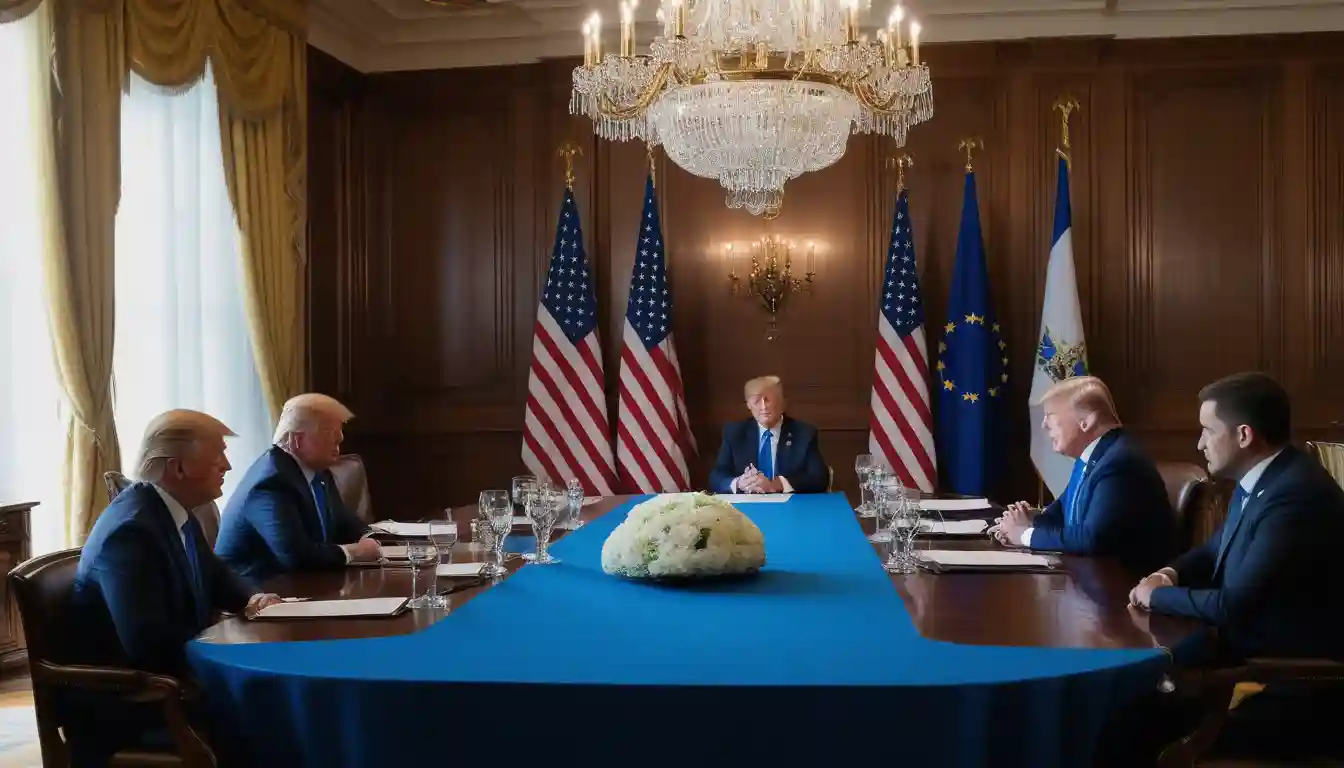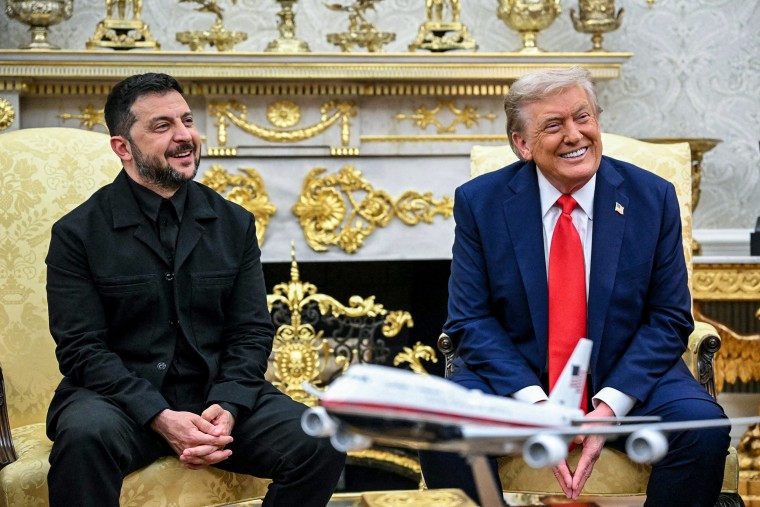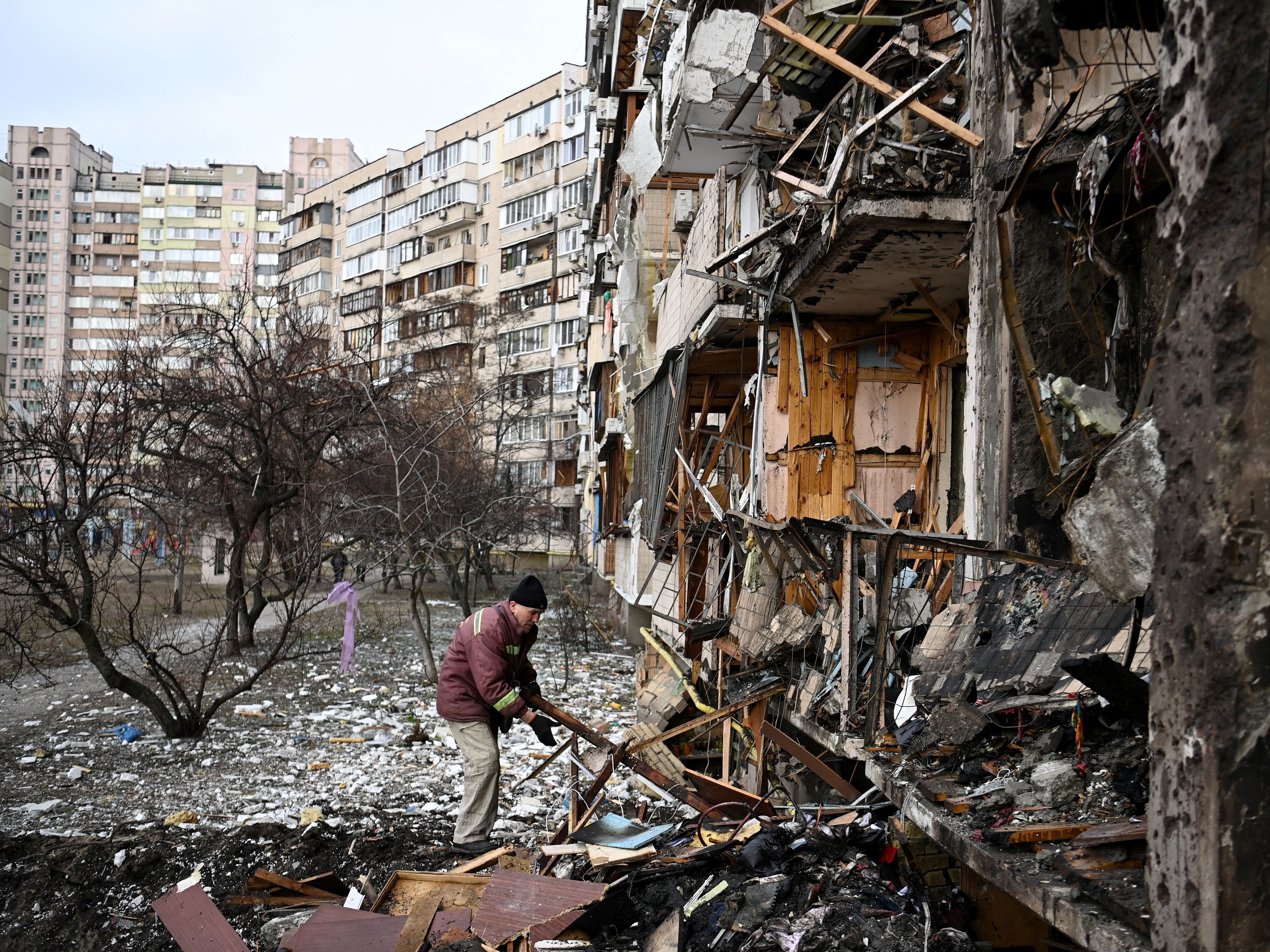
Trump Hosts Zelenskyy and European Leaders to Discuss Ukraine Territory Exchanges and Security Guarantees
The Ukrainian Gambit: Trump's High-Stakes Diplomatic Chess Match
WASHINGTON — President Donald Trump convened an extraordinary White House meeting on August 18, 2025, bringing together Ukrainian President Volodymyr Zelenskyy and seven European leaders to discuss potential pathways to ending the Russia-Ukraine war. The gathering included French President Emmanuel Macron, Italian Prime Minister Giorgia Meloni, German opposition leader Friedrich Merz, and other key European figures.

During the meeting, Trump made several significant statements that marked a potential shift in diplomatic approach. He declared that "possible territory exchanges need to be discussed" as part of any comprehensive peace settlement, signaling openness to territorial arrangements that have previously been considered non-negotiable by Ukraine and its Western allies. The President also outlined plans to provide Ukraine with security guarantees that would "resemble NATO's Article 5" protection without extending full NATO membership.
NATO's Article 5 is the cornerstone of the alliance, establishing the principle of collective defense. This principle states that an armed attack against one member is considered an attack against all members. Consequently, every other member of the alliance will take action to assist the one that was attacked.
This summit followed Trump's Friday meeting with Russian President Vladimir Putin in Alaska, where the two leaders met face-to-face but failed to secure an immediate ceasefire. According to Trump's statements, Putin had proposed that Ukraine surrender the remainder of the Donbas region in exchange for halting fighting elsewhere—a territorial arrangement that Zelenskyy has firmly opposed but which Trump indicated merits discussion.

The diplomatic developments represent a significant acceleration in peace efforts after more than two years of active conflict that began with Russia's invasion of Ukraine in February 2022. Trump's approach emphasizes comprehensive settlement over gradual ceasefire implementation, while also suggesting that formal cessation of hostilities may not be necessary to advance peace negotiations. This positioning contrasts with traditional conflict resolution approaches and reflects the administration's preference for decisive action over incremental progress.
The Alaska Aftermath: Momentum Without Agreement
Trump's Friday encounter with Putin in Anchorage—their first face-to-face meeting since the war began—produced no ceasefire but established what diplomatic sources describe as "negotiating parameters." The Russian leader's reported proposal that Ukraine surrender remaining Donbas territories in exchange for a halt in fighting elsewhere has become the unstated framework driving current discussions.
"The Alaska meeting changed everything," observed a senior European diplomat present at Monday's White House gathering. "Putin signaled willingness to engage seriously, but his terms remain maximalist. The question now is whether compromise is mathematically possible."
The timing reflects both opportunity and desperation. After two years of grinding attrition, both Moscow and Kyiv face domestic pressures to show progress. Russia's incremental battlefield gains have come at enormous cost, while Ukraine's Western-supplied arsenal has proven insufficient to achieve decisive territorial recovery. The stalemate has created what conflict resolution specialists term "mutually hurting equilibrium"—the precondition for serious negotiations.
A "Mutually Hurting Equilibrium" is a stalemate in a conflict where both parties are experiencing unbearable costs and see no clear path to victory. This shared pain can create a "ripe moment" for resolution, making both sides more receptive to negotiation as an escape from the damaging deadlock.
The Two-Week Window: Diplomatic Theater or Genuine Deadline?
Trump's assertion that the international community "may know within two weeks" whether peace is achievable represents more than political theater. Intelligence assessments suggest Putin faces mounting economic pressure from prolonged sanctions, while Ukraine's ability to sustain high-intensity operations depends increasingly on Western support that remains politically fragile in European capitals.
The economic impact of sanctions on Russia's GDP since 2022.
| Year/Quarter | GDP Growth Rate (%) |
|---|---|
| 2022 | -1.2 |
| 2023 | 3.6 |
| 2024 | 2.9 |
| Q1 2025 | 1.4 |
| Q2 2025 | 1.1 |
| 2025 (Yearly Forecast) | 1.7 |
The compressed timeline reflects Trump's trademark preference for dramatic, time-bound negotiations. But diplomatic veterans warn that complex territorial and security arrangements cannot be rushed without risking catastrophic implementation failures.
"Fourteen days to resolve a conflict of this magnitude is ambitious to the point of recklessness," cautioned a former State Department official with extensive Russia experience. "But if it forces all parties to make hard choices they've been avoiding, it could break the deadlock."
European Divergence: Unity Under Strain
The presence of French President Emmanuel Macron, Italian Prime Minister Giorgia Meloni, German opposition leader Friedrich Merz, and other European figures underscored both continental unity and emerging fractures. While publicly supportive of Trump's mediation efforts, European leaders privately expressed reservations about territorial compromises and the adequacy of proposed security arrangements.
Macron's suggestion of a "quadrilateral" negotiating format—potentially including France alongside the United States, Russia, and Ukraine—reflects European determination to remain central to any settlement. The proposal acknowledges European concerns that bilateral U.S.-Russia arrangements could sacrifice Ukrainian sovereignty for American domestic political gains.
"Europe cannot accept a Yalta-style division imposed by nuclear powers," a senior French official noted privately. "Any sustainable settlement must include robust European enforcement mechanisms."
German opposition leader Merz's warning that "next steps would be more complicated" signals potential resistance to hasty territorial arrangements. His position reflects broader German anxiety about legitimizing conquest through negotiation—a principle with obvious implications for European security architecture.
The Security Guarantee Puzzle: Deterrence or Diplomatic Fiction?
Trump's offer of "very good protection and very good security" to Ukraine represents the negotiation's most complex element. The proposed guarantees—described as NATO-like but short of full membership—would need to balance credible deterrence against Russian aggression with domestic American reluctance to assume new military commitments.
Financial markets immediately recognized the arrangement's transformative potential. A credible security umbrella could dramatically reduce Ukrainian sovereign risk and enable massive reconstruction investment. Conversely, weak guarantees that fail to deter future Russian aggression could institutionalize frozen conflict with recurring crisis potential.

Defense analysts note that effective guarantees require either treaty-level commitments with automatic response triggers or permanent military deployments that establish tripwire credibility. Trump's apparent preference for European-led implementation suggests an arrangement closer to political commitments than military alliances.
"The guarantee's value depends entirely on its automaticity," explained a senior fellow at a prominent Washington think tank. "Anything requiring case-by-case decisions will be discounted by both Moscow and financial markets."
Investment Implications: Navigating Volatility Amid Uncertainty
The diplomatic developments carry profound implications for multiple asset classes. Energy markets face potential volatility as peace prospects could reduce geopolitical risk premiums that have supported oil prices since the conflict began. European natural gas markets, heavily influenced by Russian supply considerations, remain particularly sensitive to settlement prospects.
European natural gas price volatility since the start of the Russia-Ukraine war.
| Date | Event | Price (EUR/MWh) | Significance |
|---|---|---|---|
| March 2022 | Invasion of Ukraine leads to market uncertainty. | 345 | All-time high for European natural gas (TTF). |
| August 2022 | Reductions in Russian pipeline gas supply. | 233.676 | Record-high summer prices, exacerbating the energy crisis. |
| Early 2025 | Reduced Russian gas transit and colder winter. | ~47 | Prices surged to their highest level in two years, remaining double the pre-crisis levels. |
Emerging market sovereign debt could benefit from reduced global risk perceptions, while European equities—particularly industrial and infrastructure sectors—stand to gain from decreased regional uncertainty. Ukrainian debt instruments, trading at deep discounts, represent the highest-risk, highest-reward positions dependent on settlement terms.
Currency markets have already begun positioning for potential outcomes. The euro strengthened against the dollar following the summit announcement, reflecting investor optimism about reduced continental instability. However, sustainability depends on the credibility of eventual security arrangements.
Investment strategists recommend cautious positioning given the negotiations' binary nature. "This is either a genuine breakthrough or an expensive diplomatic theater," noted a senior portfolio manager at a major European fund. "Portfolio construction should reflect both possibilities."
The Prisoner Exchange Calculus: Humanitarian Leverage
Trump's revelation that Putin could release "over 1,000" Ukrainian prisoners of war demonstrates the negotiation's humanitarian dimension while illustrating Russia's tactical approach. The staged release of prisoners—a classic confidence-building measure—provides Moscow with leverage to extract sequenced concessions during formal talks.
The prisoner issue highlights the negotiation's moral complexity. While families desperate for loved ones' return may support territorial concessions, Ukrainian civil society broadly opposes legitimizing conquest through accommodation. This tension between immediate humanitarian relief and long-term sovereignty principles complicates domestic Ukrainian politics.
Intelligence assessments suggest prisoner releases will be calibrated to negotiating progress, with initial modest gestures potentially expanding to larger exchanges if territorial discussions advance. The dynamic creates pressure on Ukrainian negotiators to show flexibility on other issues.
Market Positioning: Calculated Risk in Uncertain Times
Professional investors face challenging positioning decisions as negotiations unfold. Energy sector exposure requires careful hedging given oil's sensitivity to peace prospects. European equity allocations may benefit from reduced regional risk, but depend heavily on settlement quality and enforcement credibility.
Fixed income strategies should consider potential yield curve impacts from reduced risk premiums, while currency positioning must account for shifting safe-haven demand. Emerging market exposure benefits from global risk reduction but faces headwinds from potential commodity price normalization.
The Ukrainian sovereign debt market presents extreme asymmetry—massive upside from successful peace implementation against total loss from negotiation failure. Sophisticated investors may consider small allocations with tight risk management, recognizing the binary nature of potential outcomes.
Investment decisions should be made in consultation with qualified financial advisors. Past performance does not guarantee future results, and geopolitical developments carry substantial uncertainty.
The Path Forward: Fragile Momentum Meets Harsh Reality
As Trump prepares his promised call to Putin, the negotiation's fundamental tension becomes clear. The President's preference for comprehensive settlement over gradual ceasefire contradicts European and Ukrainian preferences for sequenced implementation. This disagreement could determine whether current momentum produces lasting peace or merely temporary positioning.
The two-week timeline, while politically expedient, may prove diplomatically unrealistic. Complex territorial arrangements, security guarantee implementation, and prisoner exchange logistics require extensive technical negotiation beyond political agreements. Success depends on all parties' willingness to accept partial satisfaction of their maximal objectives.
Financial markets will monitor three key indicators: the scope and automaticity of security guarantees, the specificity of territorial arrangements, and the robustness of enforcement mechanisms. These factors will determine whether any agreement produces genuine stability or merely postpones inevitable confrontation.
The stakes could not be higher. Success could reshape European security architecture and unlock massive reconstruction investment. Failure risks not only continued conflict but damaged American credibility and fractured Atlantic relationships. In this high-stakes diplomatic chess match, Trump has moved his pieces boldly—but the game's outcome remains far from certain.